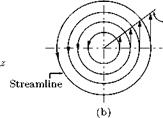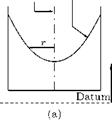Forced Vortex
Forced vortex is a rotational flow field in which the fluid rotates as a solid body with a constant angular velocity ю, and the streamlines form a set of concentric circles. Because the fluid in a forced vortex rotates like a rigid body, the forced vortex is also called Bywheel vortex. The change of total energy per unit weight in a vortex motion is governed by Equation (5.65).
The velocity at any radius r is given by:
|
V = юг |
|
From this we have: |
|
and |
|
V — = ю. r |
|
Substituting dV/dr and V/r into Equation (5.65), we get: |
|
dH юг — = —(ю + ю) dr g |
|
2ю2г g ‘ |
|
Integrating this we get: |
|
(5.66) |
|
H = ——- + с, g |
|
where с is a constant. By Bernoulli equation, at any point in the fluid, we have: |
|
p V2 H =——– + T)—+ z. pg 2g |
|
|
|
|
|

Note that, in the above equation and Equation (5.66), the unit of the total head is meters. Substitution of this into Equation (5.66) results in:
|
P |
-2r2 |
-2r2 |
||
|
+— “— |
+ z = |
z —– |
+ c |
|
|
Pg |
2g |
g |
||
|
P |
– 2 r2 |
|||
|
+ z = |
+ c. |
|||
|
Pg |
2g |
If the rotating fluid has a free surface, the pressure at the surface will be atmospheric; therefore, the pressure at the free-surface will be zero.
P
Replacing — with 0 in the above equation, the profile of the free surface is obtained as:
 |
|
Pg
Thus, the free surface of a forced vortex is in the form of a paraboloid.
Similarly, for any horizontal plane, for which z will be constant, the pressure distribution will be given by:
22
– = – rj – + (c – z). (5.68)
Pg 2g
The typical shape of the free surface and the velocity variation along a radial direction of a forced vortex are shown in Figure 5.37.












